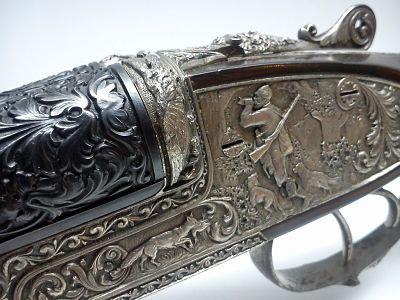La Paloma Shotgun Mod. PR, engraved by Mateo Careaga.

As is known, an enormous mural painted by Picasso captured all the attention in the Spanish pavilion at the International Exposition of Art and Technology held in 1937 in Paris: Gernika, created in response to the events of April 26 in the town of the same name, and which would become an important symbol against the war.
Although they went rather more unnoticed, gunsmiths and engravers from Eibar were also present at that exposition to display their work and share the knowhow of the people of Eibar with the world. The exhibition we have prepared pays tribute to all of those artists, as does the piece chosen for this month, which was on display at that Parisian exposition: the La Paloma Mod. PR shotgun engraved by Mateo Careaga.
This hunting shotgun was manufactured in 1928 by the company Viuda e hijos de Juan José Sarasqueta. Juan José Sarasqueta started working as a gunsmith together with his brother Victor Sarasqueta in 1887. However, in time each went his own way, and in 1904 Juan José registered the La Paloma brand to distinguish his shotguns. After his death, the company changed its name to Viuda e hijos de Juan José Sarasqueta and continued its professional activity from 1920 until 1975.
Concentrating on its more technical aspects, we can say that this is a single-shot muzzleloader, 12mm calibre and with central percussion. It is manually loaded, and the barrels are break-open. Both the hammers and the trigger safety lock are joined to the side plate. If you look carefully, you will see that the gun has two triggers, the first activates the right-hand barrel and the second the one on the left.
The decoration too is enormously important in this piece, given that it is adorned with beautiful bas-reliefs created by the engraver Mateo Careaga. On the side plate you can see traditional hunting scenes and different floral motifs engraved in relief. As for the designer, Mateo Careaga came from a family of engravers from Eibar. He created works of great historical value, such as the coins of the Council of Asturias and León in 1937. He is also known for having been given the task of raising the Republican flag for the first time when the Second Republic was proclaimed in Eibar on April 14, 1931. He was granted this honour for being the youngest councillor in the Corporation (he was a member of the Republican Action group).
As well as being in the 1937 exposition, this shotgun was presented to King Alfonso XIII on a visit by the monarch to the Astra, Unceta y Cia factory in 1928. It is obvious, therefore, that this weapon has an interesting historical background and that it is a fabulous example of the quality and value of the work of the Eibar gunsmiths.
It is subsequently hard to believe that the shotgun was lost after the Paris exposition, and that nothing was known of its whereabouts until the side plate turned up in an Eibar repair shop in the ‘50s. Astonished by the origin of the engraving, the workers contacted the damascene expert Pablo Sarasua, who just happened to be Mateo's uncle. Given that the barrel and the butt were missing, the weapon had to be rebuilt, but it finally returned to the hands of the Careaga family. Thus, 30 years after its creation, Mateo added the decorative details to the barrel.

